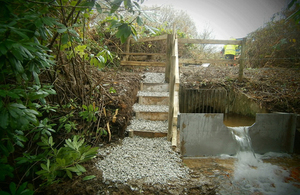
The polluting outfall near to Coombe
Members of the local community are invited to attend the event, which will take place from 1.30pm until 7pm on Thursday, 6 June at the Coombe Community Hall, St. Austell.
Representatives from the Environment Agency and the Coal Authority will be there to explain how the proposed scheme will work and answer questions about river pollution from abandoned mines in Devon and Cornwall.
Monitoring by the Environment Agency has revealed that up to 14 km of the Coombe Stream, Gwindra Stream and upper River Fal is polluted by the metals cadmium and zinc from historical local metal mining.
The Coombe outfall, which drains the former Dowgas mines is the main source of these polluting metals. Treatment of this mine water would stop pollution of these rivers.
The proposed pilot-scale scheme to remove metals from the Coombe outfall has been developed for the Coal Authority and Environment Agency to trial the technology at a relatively small scale for a couple of years.
The scheme is part of the national Water and Abandoned Metal Mine Programme, a partnership between the Department for Environment, Food and Rural Affairs, the Coal Authority and the Environment Agency to help deliver the government's 25 Year Environment Plan and River Basin Management Plans by cleaning up the polluting legacy of abandoned metal mines across England.
Further details about how the Environment Agency and the Coal Authority are tackling water pollution caused by historical metal mining in England can be found at https://www.gov.uk/government/collections/metal-mine-water-treatment
You can confirm your attendance at this public drop in meeting through the Facebook event page






